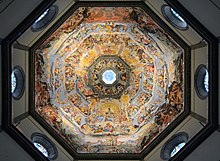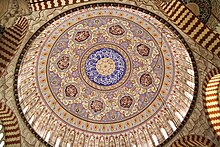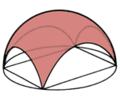dome
A dome (from Latin cupula "small barrel") or cathedral is the name given in architecture to a vault with only one apex, which has been one of the most sophisticated structural elements in architecture for 5,000 years from a few to hundreds of meters. They rise above a circular or angular floor plan. The spherically shaped room covers are constructed by rotating a semicircle, elliptical, parabolic or pointed arch around a vertical axis. In general, these are the hemispherical or bell-shaped upper parts of a room.
In sacred architecture, a cylinder-shaped, window-pierced drum wall leads to the pendentif , the transition walls , usually consisting of four to eight segments, to the building floor plan. The entire perimeter of their ground plan serves as an abutment . Systems of semi-arches and semi-domes direct the forces of the weights of post-medieval domes up to 65,000 tons downwards. Since the Renaissance, it was the introduction of double shells and, since the Baroque, the use of iron or lead, which helped to imitate or surpass the centuries-old building of Hagia Sophia, which originally measured 33 m in diameter. Such large domes required special knowledge of geometry and civil engineering, in which in antiquity the writing of the Heron of Alexandria ( About Vaults ) provided the theoretical basis and, creatively implemented by Anthemios von Tralleis and Isidor von Milet , a classic solution for a completely new paradigm Christian architecture offered. In competition with antique models of the dome of the Renaissance, in which stood Leon Batista Alberti authoritative theorists and Filippo Brunelleschi , Bramante and Michelangelo creative converter of the domes in the Florence Cathedral and St. Peter's Basilica and thus models were in the Baroque. Another paraphrase of the Renaissance dome is Christopher Wren's dome of St Paul's Cathedral , which in turn was taken as a direct neoclassical takeover in the dome of the Capitol in Washington and in many other states as an architectural expression of political representation. In Germany and Austria, after the Baroque period, historicism in particular formed a time in which representative buildings such as the Karlskirche in Vienna , the Berlin Cathedral or the Reichstag building as domed structures became dominant motifs in the visual presentation of a city.
Domes are usually made of stone , brick , concrete , wood , various metals or other materials. The actual dome is the ceiling composed of wedge-shaped stones , which freely spans the room , which is partially or completely enclosed by walls .
In terms of engineering, continuously curved domes are counted as double-curved shells , segmented domes ("umbrella domes") as folded structures . Historical forerunners of pendentive domes are cantilever domes.
Designs
In addition to the cross-section, the relationship between the (imaginary) dome floor plan, the “foot circle”, and the room floor plan determines the shape of a dome. Domes over a rectangular room must either be trimmed or added.
- The most general shape is the dome in the shape of a hemisphere. Later (often segmented) domes are often bulged and usually double-shelled.
- "Umbrella domes" are segmented domes with ridges or ribs .
- When the base circle of the dome touches the corners of the floor plan, the shell is cut perpendicularly from the walls. This shape is called "hanging dome".
- If the foot circle lies further outside the ground plan, a “spherical dome” or “flat dome” is created which, as a spherical dome, is flatter than a hanging dome. A “Bohemian cap”, also known as a “Stutzkuppel” or “Platzlgewölbe”, emerges from it over a square floor plan.
- If the base circle of the dome is inscribed in the plan (the walls as tangents), an incomplete hanging dome is placed between the walls and the actual dome, which is cut horizontally and the vault rests on the cut edge. The four segments of the "auxiliary dome" are called pendentif , the dome shape afterwards "pendentifkuppel".
- A tambour , a cylindrical element that raises the dome and is often pierced with windows, is often connected between the pendentives and the dome . The tambour, like the adjoining dome, can also have an octagonal shape.
- Instead of pendants, trumpets and (especially in Turkish and Indian architecture) " Turkish triangles " occur with the same function , which fill the corners with cone segments or pyramids rather than spherical segments.
- A “folding dome” is a dome with an outwardly curved surface that appears to be folded.
The statics of these designs is comparable to that of cross vaults , but more complex because the side pressure does not only act on the corners.
exposure
The dome itself or the space below it was illuminated either through the opaion ("eye"), an opening in the apex that has often been covered by a windowed lantern since the Middle Ages , or through openings in the lower area of the shell (e.g. . Hagia Sophia ). Later, a windowed drum was often interposed, making the dome seem to float.
history
Cantilever domes
Preforms of the real domes are those that have existed since the 7th millennium BC. Tholos buildings that were built in the Middle East and the Mediterranean region (e.g. the Neolithic Tholos of El Romeral near Antequera ( Andalusia ), the so-called treasure house of Atreus in Mycenae ( Peloponnese ) from around 1250 BC or the Sardinian Nuraghi , all first the Nuraghe Arrubiu ). Also worth mentioning are the numerous small cantilever vaulted structures made of dry stone , the origins and historical development of which are still largely unclear.
All Tholos buildings have a round floor plan so that there were no adjustment problems at the transition from the room to the dome. Later cantilever domes over square or octagonal rooms never rest on trumpets or pendants - the transition from square to round dome is achieved by permanently doubling the substructure up to 16 or even 32 corners.
In the Hindu architecture of the Middle Ages (about 900 to 1450) special groups flourished Kragkuppeln. In particular the vestibules ( mandapas ) of Hindu and Jain temples were spanned by them up to a maximum width of about 8 m; hanging keystones ( hangers ) played a major role.
Cantilever domes were built even in the early days of Islam in India; only with the arrival of the Mughals (around 1526/7) did the situation change and only “real domes” were constructed. In some new temples in the 20th century, however, cantilever techniques are used again.
The mausoleum of Theodoric in Ravenna , which was built around 520/30, has a false monolithic dome .
Real domes


Antiquity
The oldest real domes with vaulted stones date back to the Etruscan era , the dome construction reached its high points in Roman antiquity with the rotunda in the Pantheon in Rome (see list of Roman domes ). The round halls of Roman imperial baths were also regularly vaulted with domes. The architectural idea of the central church of the Eastern Roman Empire of Hagia Sophia , built under Emperor Justinian I in Constantinople in the Byzantine Empire, of placing a free-standing pendent dome on four bays above the square central space, gave sacred Christian architecture its pioneering model. The free-standing dome of Hagia Sophia did not only remain the largest in the world for the next 900 years, its complex geometry, which can only be deduced from the floor plan but not from the consideration of the individual structural elements, did not allow for repetition and was also without imitation. The forces of the 33 m spanning dome were intercepted by massive pillars and half-domes, similar to the domes built in the Renaissance in Florence and St. Peter's Basilica, but in Hagia Sophia this massive tectonics is used to support the huge dome by means of a game of puzzles between the clear geometry of their building structure and their simultaneous visual dematerialization by a flat decoration system "hidden. The dome of Hagia Sophia forms the center of an elongated main room as a fusion of central and longitudinal space. It therefore only has half-domes in the west and east, under which eccentric apses are arranged. In the south and north, the dome mass is diverted to the outside by buttresses that do not appear in the interior, which in the flanking two-story aisles with large columns placed between the pillars required a special depth and gives the overall structure the compact appearance of a symmetrically designed central building. Inside, too, the colored marble cladding negates any tectonic connections, as there are only horizontal stripes, but no vertical lines. The Hagia Sophia could hardly be represented with the help of two-dimensional projection from the intersections of geometric figures and conglomerates of simple barrel and groin vaults with incised hemispherical shells. It is due to the geometric complexity and the resulting confusing spatial effect that their spatial concept of merging the central room and basilica and the necessary geometries of the dome construction could not be repeated in historical times. In particular because no textual description of the building concept was handed down and any explanations were therefore available purely from the context of the building as the only original source. The purely numerically oriented surveying system of antiquity (geodaisia), to which a comprehensive system of rational numbers developed by Greek mathematics (logistike) was available, formed the basic requirement for the construction of this dome and was no longer available to later generations of architects.
middle Ages
The dome formed an essential basic type of early Christian art also north of the Alps, where it was first realized in the coronation church of the German emperors in Aachen Cathedral under Charlemagne . Since the Middle Ages, almost all domes have been given a central elevation in the form of a lantern or a 'ball stick' ( jamur ).
- Europe
In Byzantine architecture, the inscribed cross with a dome over the naos formed the predominant building type, which remained the style-forming element in the Orthodox countries of Europe. From the model of the palace church of Constantinople, Nea Ekklesia , the Byzantine five- domed churches, built since the tenth century, were derived as a four-pillar structure with a barrel cross that supports the dome and four columns or pillars. It also spread to the countries of the Balkans and Russia via direct architectural models in Constantinople and Thessaloniki. In particular, in the Episcopal Church in Gračanica Monastery, a stronger vertical accentuation was achieved through elongated drums.
The medieval church building in Catholic Europe preferred the ( cross or barrel vaulted ) longitudinal over the central building and gave the dome architecture - apart from a few buildings in south-west France ( cathedral of Périgueux , abbey church of Souillac, etc.) - certain possibilities of development only above the crossing . The domed central building, however, retained the type of baptistery , the replicas of the Church of the Holy Sepulcher in Jerusalem and special cases such as the Palatine Chapel in Aachen and its successors. Important dome buildings of the Middle Ages are the baptisteries of Parma (1196–1270), Cremona (from 1176) and Florence (11th / 12th centuries, largest dome of the Middle Ages, diameter 25.60 m), all with a polygonal floor plan. The baptistery of Pisa (from 1152) was covered with a conical vault (originally with an open tip), a special shape. The Byzantine cross-domed churches continued the tradition of the domed vault, which is reflected in San Marco in Venice, from where apparently inspiration for the domed churches of the Périgord ( Périgueux , Angoulême etc.) originated.
Brunelleschi's dome of Florence Cathedral (1420–36, diameter 45.52 m) marks a technical breakthrough and a new dimension in vaulting. It is designed as a double-shell brick dome based on the model of the Timurid Gur-Emir mausoleum (around 1405) in Samarqand , but without adopting its bulge . With the new Renaissance style, the central building and the monumental crossing dome with drum became the new ideal. Michelangelo 's St. Peter's Basilica in Rome served as a model well into the baroque era . Often the dome that is visible to the outside is now significantly higher than the interior dome.
In the 18th and 19th centuries , in particular , secular buildings , especially government buildings , were given domes, such as the Reichstag in Berlin or the Capitol in Washington .
- Islam
In Islamic architecture, the Hagia Sophia became the prototype of the Ottoman mosque and the dome construction achieved a great variety of shapes: The spectrum ranges from small rib domes ( Mezquita-Catedral de Córdoba ; El Cristo de la Luz , Toledo) to domes in the Byzantine tradition ( Dome of the Rock , Jerusalem) to the double-shell domes of the Mughal architecture of India ( Humayun mausoleum , Delhi or Taj Mahal , Agra ).
The tracery-like openwork domes of three Merinid mosques that span the yoke in front of the mihrab niche in the mosque buildings of Tlemcen , Taza and Fès-el-Jedid are a delightful specialty - unfortunately only older photos exist. Perhaps Johannes of Cologne , the master builder of Cimborio over the crossing of the Burgos Cathedral, knew the Moroccan models and created a small masterpiece in the 15th century, which however had to be renewed after its collapse around 1550.
Significant real domes


- For a list of the largest domes by diameter, see List of Largest Domes of their Time .
In the order of their establishment:
| Construction year | Building | place | diameter | additions |
|---|---|---|---|---|
| around 50 BC Chr. | so-called Merkur temple (actually part of a thermal bath) | Baiae, Italy | 21.50 m | |
| 125 AD | Pantheon | Rome, Italy | 43.3 m | |
| 547 | San Vitale | Ravenna, Italy | 16 m | |
| 563 | Hagia Sophia | Istanbul, Turkey | 31 m | First large pendentive dome over four bays, originally 33 m. |
| about 700 | Dome of the Rock | Jerusalem, Israel | 21 m | |
| 1067/68 and 1093 | Charagan twin tomb towers | Qasvin, Iran | ||
| 1227 | St. Gereon | Cologne, Germany | 21-16.90 m | |
| circa 1340 | Jama Masjid | Gulbarga, India | 35 m | |
| 1434 | Santa Maria del Fiore | Florence, Italy | 42-45 m | |
| 1557 | Suleymaniye Mosque | Istanbul, Turkey | 27.25 m | |
| 1575 | Selimiye Mosque | Edirne, Turkey | 31.3 m | |
| 1593 | St. Peter's Basilica | Rome, Italy | 42.34 m | |
| 1616 | Sultan Ahmed Mosque | Istanbul, Turkey | 23.5 m | |
| 1659 | Gol Gumbaz | Bijapur, India | 37.9 m | |
| 1708 | St Paul's Cathedral | London, England | 30.8 m | Christopher Wren's 111.3 m high dome weighs around 65,000 tons and consists of three shells |
| 1737 | Karlskirche | Vienna, Austria | 25 m | |
| 1743 | woman Church | Dresden, Germany | 26.15 m | Reconstruction completed in 2005 |
| 1781 | St. Blaise Cathedral | Black Forest | 36 m | |
| 1841 | Isaac's Cathedral | Saint Petersburg, Russia | 26 m | Height 101.5 m |
| 1843 | St. Nikolai | Potsdam, Germany | 24 m | Height 13 m; Drum height 28 m; total 77 m |
| 1863 | Capitol | Washington, USA | 29 m | |
| 1871 | Rotunda Santa Marija Assunta | Mosta, Malta | 39 m | |
| 1894 | Frederiks Kirke (marble church) | Copenhagen, Denmark | 31 m | |
| 1913 | Centennial Hall | Wroclaw, Poland | 65 m | |
| 1913 | "Concrete hall" | Leipzig, Germany | 32 m | |
| 1920 | First Goetheanum | Dornach, Switzerland | 12 + 17 m | Double dome, made entirely of wood (burned down) |
| 1926 | Jena Planetarium | Jena, Germany | 25 m | |
| 1929 | Market hall Basel | Basel, Switzerland | 60 m | |
| 1929 | Wholesale market hall | Leipzig, Germany | 66 m | |
| 1963 | Centennial Hall | Frankfurt am Main, Germany | 86 m | |
| 1975 | Louisiana Superdome | New Orleans, Louisiana, USA | 207.3 m | |
| 1978 | Rotunda from Xewkija | Xewkija, Malta | 27 m | |
| 1989 | Stockholm Globe Arena | Stockholm, Sweden | 110 m | |
| 1989 | St. Sava Cathedral | Belgrade, Yugoslavia | 30.5 m | With 4000 t heaviest dome which was pushed to a height of 40 m using a lift slab system |
| 2000 | Eden Project | Cornwall, England | 125 m |
By using reinforced concrete and steel frameworks, modern domes (shell structures) can be built in far bolder shapes and with a larger span than stone or brick structures. Richard Buckminster Fuller constructed geodesic domes in lightweight construction.
At the Vienna University of Technology, Institute for Supporting Structures, a construction method called "Pneumatic Forming of Hardened Concrete (PFHC)" was developed, in which the elaborate arched scaffolding for shaping a reinforced concrete dome is replaced. A reinforced concrete slab with wedge-shaped recesses is poured on one level. Its elements are arched up by inflating a pneumatic membrane and tightly joined together by tensioning an all-round pulling rope using hydraulic presses to form a dome, which can be reinforced and stiffened by adding another layer of concrete.
Special forms

Canopies such as that of The O₂ (formerly Millennium Dome) in London , which consists of a fiberglass membrane supported on the outside with steel cables , often have a dome shape, but are not domes because they are not self-supporting, but - comparable to circus tents - with supports are kept in their shape.
Air domes and inflatables can bulge in the shape of a dome, but their tensile membrane is supported by the air (excess) pressure of the interior space and tensile stresses in the membrane.
Concave structures seen from above, which are only held at the edge, can be constructed from only tensile strength material. Antennas for radio astronomy made from steel cable networks, trampolines made from sewn, woven synthetic fiber tapes, small fitness equipment made from woven plastic wire. This flexible design is the most material-saving. A purely pressure-resistant and (to a limited extent) rigid dome represents the double counterpart in terms of tangential and radial forces. In both cases, the cause of the forces is gravity (acceleration due to gravity). Loads and disturbances are caused by wind power, static air pressure differences, pressure surges from explosions or avalanches or tidal waves, water currents, snow cover or overlay by earth or mountains, mechanical impact, such as an aircraft.
See also
Web links
- Beatrice Härig: The weightlessness of the stones. On the fascination of the domes as a structural element , in: Monuments Online 6.204
literature
- Oscar Schneider : Fight for the dome. Architecture in a democracy. Bouvier Verlag, Bonn 2006, ISBN 3-416-03076-1 .
- Ananda Kentish Coomaraswamy : Symbolism of the Dome. Delhi 1938.
Individual evidence
- ↑ Monuments, 2014/6 On the fascination of the domes as a structural element - The weightlessness of the stones
- ↑ St. Paul's Cathedral St. Paul's Cathedral - Climb the Doe
- ↑ Helge Svenshon: The building as "aistheton soma": a reinterpretation of Hagia Sophia in the mirror of ancient surveying and applied mathematics. In: Falko Daim, Jörg Drauschke (Hrsg.): Byzanz - The Roman Empire in the Middle Ages. RGZM monographs. 84.2.1. Mainz 2010, ISBN 978-3-88467-154-2 , pp. 59-95.
- ↑ Jörg Lauster 2012: Why are there churches? Rome - Jerusalem - Constantinople. In: Thomas Erne 2012 (Ed.): Church building. 23–33, Vanderoeck & Ruprecht, Göttingen. ISBN 978-3-525-56852-1
- ↑ Hans Staub 2013: The history of civil engineering: an overview from antiquity to modern times. Jumper. P. 114 ISBN 978-3-0348-4109-2
- ↑ Burgendaten.de - Czech cap accessed 30 June 2011
- ↑ Helge Svenson 2010: THE BUILDING AS »AISTHETON SOMA« - A REINTERPRETATION OF HAGIA SOPHIA IN THE SPIEGEL OF ANCIENT MEASUREMENT AND APPLIED MATHEMATICS. In: Falko Daim · Jörg Drauschke (Ed.) Byzanz - the Roman Empire in the Middle Ages Part 2, 1 scenes, Roman-Germanic Central Museum Research Institute for Prehistory and Early History [1]
- ↑ Jörg Lauster 2012: Why are there churches? Rome - Jerusalem - Constantinople. In: Thomas Erne 2012 (Ed.): Church building. 23–33, Vanderoeck & Ruprecht, Göttingen. ISBN 978-3-525-56852-1 , here pp. 30–31.
- ↑ Helge Svenson 2010: p. 59
- ↑ Helge Svenson 2010: p. 63
- ^ Heinz Otto Lamprecht: Opus Caementitium , Römisch-Germanisches Museum Köln, Beton Verlag, 5th edition, Düsseldorf 1996, ISBN 3-7640-0350-2 , p. 129
- ↑ Helge Svenson 2010: THE BUILDING AS »AISTHETON SOMA« - A REINTERPRETATION OF HAGIA SOPHIA IN THE SPIEGEL OF ANCIENT MEASUREMENT AND APPLIED MATHEMATICS. In: Falko Daim · Jörg Drauschke (Ed.) Byzanz - the Roman Empire in the Middle Ages Part 2, 1 scenes, Roman-Germanic Central Museum Research Institute for Prehistory and Early History [2]
- ↑ St. Paul's Cathedral - Visit the Dome
- ↑ deutsche bauzeitung: engineer portrait Franz Dischinger, p. 70 ( Memento from September 27, 2007 in the Internet Archive ) (PDF; 1.2 MB)
- ↑ Leipzig wholesale market hall. In: Structurae
- ↑ Lift-Slab Method Cathedral of St. Sava
- ↑ How to inflate an 80t concrete shell science.apa.at, January 10, 2017, accessed on January 22, 2017.














